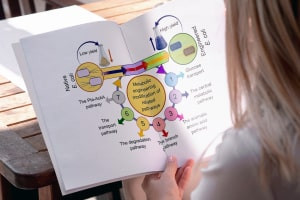Metabolic engineering has been likened to traffic management, where carbon and other atoms are the people, metabolites are their locations, and enzymes are the vehicles that transport them. In this introductory course, you learn how modifications of specific biochemical reactions of an organism can enhance the production of desired metabolites via recombinant DNA technology. Discover how to identify biochemical reaction targets, and then apply molecular biology techniques for enzyme amplification and modifications. The steps of microbial cell engineering, including host selection, parts assembly etc as well as the important metabolites and chemical end products, will be studied. Examine important research concepts like Biofundry, vital tools like CRISPR Cas9, and obtain the preliminary skills for their application. The material outlines the major aspects, including cell physiology, fluxomics, and synthetic biology. Also, the basic research techniques in metabolomics and metabolic flux analysis will be discussed. You discover why metabolic engineering is the method for in vitro evolution, and acquire the skills for its application in evolutionary systems. Study how to use bioengineering processes to up-regulate pathways of interest via the biological system’s machinery for maximal product yields. Discover the enzyme specificity, and pathway inhibition mechanisms in microbial engineering, plus, how you can enable the synthetic components, and activate the expression regulators. You will discern the focal theme and crucial steps, and see how metabolic engineering can enhance cost-effective models development via the functional schemes for commercial process support.
Next, the complex network of enzymatic reactions, such as the chemical responses and regulatory interactions that occur during cell metabolism are highlighted. Learn how to identify metabolite-centric and enzyme-centric networks, and adopt seed tests for identifying the compounds that are synthesized from the environment. The use of the Biochemical Network Integrated Computational Explorer (BNICE) for computer-aided biochemical pathways analysis is analyzed. Likewise, the chemical structure of substrates and products, and the enzymatic rules used for enzyme classification (EC) systems will be considered. Study how you can determine the complexity and diversity of the metabolic maps for feasible and observable reactions, and the advanced systems for engineering a production phenotype via the metabolic flux analysis (MFA). Modules on the overarching principles of metabolism of living systems will cover enzyme catalysis, energy harvesting, coupled reactions, as well as energy transduction to ATP via transmembrane ion gradients. The frameworks of metabolism consider the four distinct reactions which determine the primary functions of the overall cell synthesizing process. Then, you examine the dynamic timescale of metabolic reactions through allosteric control and mutational variations. Additionally, the two major processes of cellular transport will be explored. Several important concepts, including facilitated diffusion, carrier-mediated, ion-coupled, and ATP binding cassette (ABC) transport systems etc, will be presented.
Finally, the module on group translocation will highlight the phosphoenolpyruvate-sugar phosphotransferase systems (PTS) for solute transportation and phosphorylation. Learn about transporter engineering and its benefit in substrate adsorption and volumetric productivity. Study the three types of hexose monophosphates that aid the entrance of sugars into the glycolytic pathway, and the reactions (glycolysis) that facilitate their conversion into pyruvic acid. Similarly, the adenosine monophosphate pathway (AMP), pentose phosphate pathway (PPP), and Entener Doudoroff (ED) pathway, will be discussed. Likewise, the proton motive force (PMF), which drives the electrochemical proton gradient in oxidative phosphorylation will be explained. Then, the stoichiometry of oxidative phosphorylation (also known as P/O ratio) will be outlined. What are metabolic fluxes and flux maps? What is the interrelatedness of metabolic engineering and genetic engineering? This course examines these subjects and considers the facts that surround them. Whether you are a sciences student, job seeker or young scientist seeking a career path in computational biology, genetic engineering or metabolic engineering, by completing this course, you will acquire the basic skills of microbial engineering and recombinant DNA technology. Your proficiency in this subject could lead to improvements in the development of natural metabolites and products for the pharmaceutical, bioenergy, biochemical or biotechnological industries.
What You Will Learn In This Free Course
View All Learning Outcomes View Less All Alison courses are free to enrol, study, and complete. To successfully complete this Certificate course and become an Alison Graduate, you need to achieve 80% or higher in each course assessment.
Once you have completed this Certificate course, you have the option to acquire an official Certificate, which is a great way to share your achievement with the world.
Your Alison certificate is:
- Ideal for sharing with potential employers.
- Great for your CV, professional social media profiles, and job applications.
- An indication of your commitment to continuously learn, upskill, and achieve high results.
- An incentive for you to continue empowering yourself through lifelong learning.
Alison offers 2 types of Certificate for completed Certificate courses:
- Digital Certificate: a downloadable Certificate in PDF format immediately available to you when you complete your purchase.
- Physical Certificate: a physical version of your officially branded and security-marked Certificate
All Certificate are available to purchase through the Alison Shop. For more information on purchasing Alison Certificate, please visit our FAQs. If you decide not to purchase your Alison Certificate, you can still demonstrate your achievement by sharing your Learner Record or Learner Achievement Verification, both of which are accessible from your Account Settings.











 Avg. Hours
Avg. Hours  Contains Video
Contains Video  CPD Accredited
CPD Accredited 
 Total XP:
Total XP: 
 Knowledge & Skills You Will Learn
Knowledge & Skills You Will Learn 







